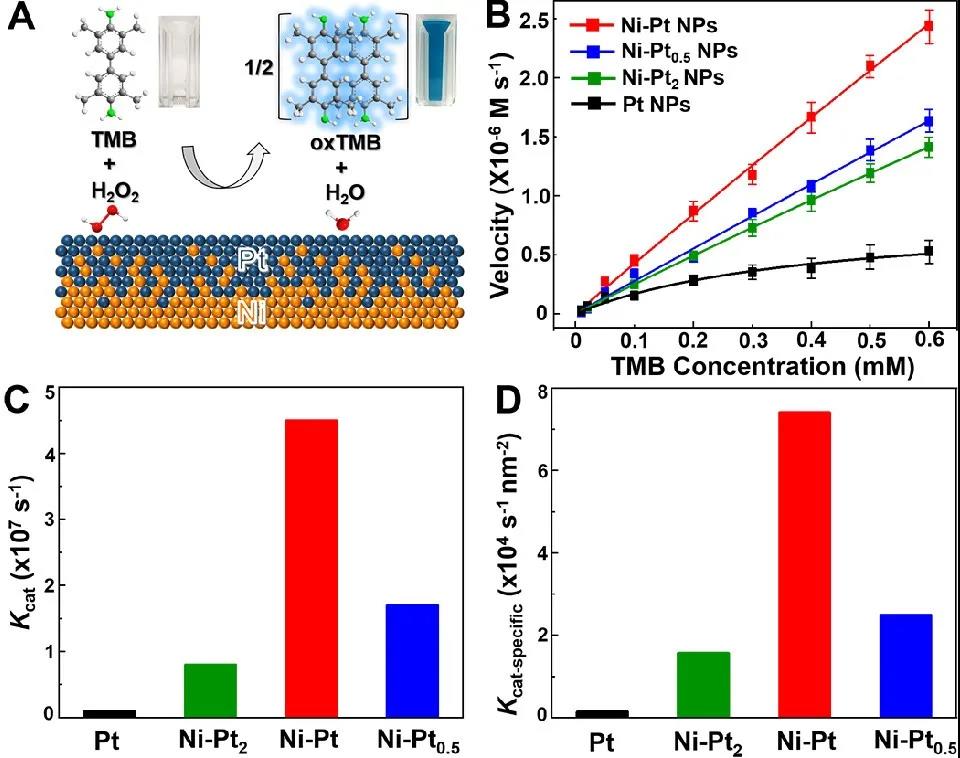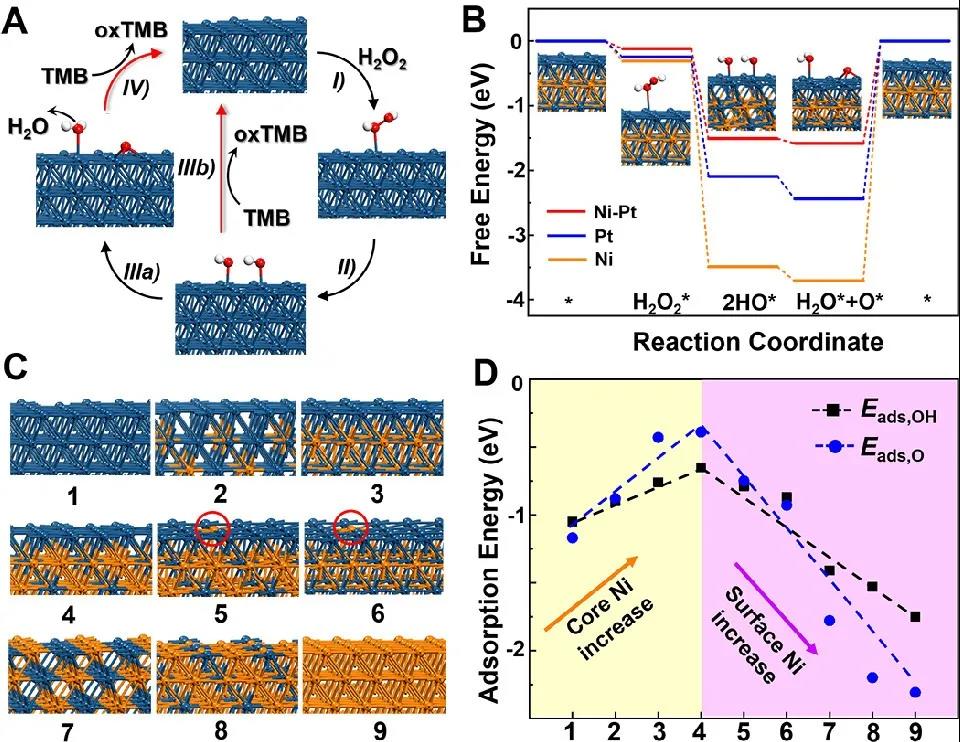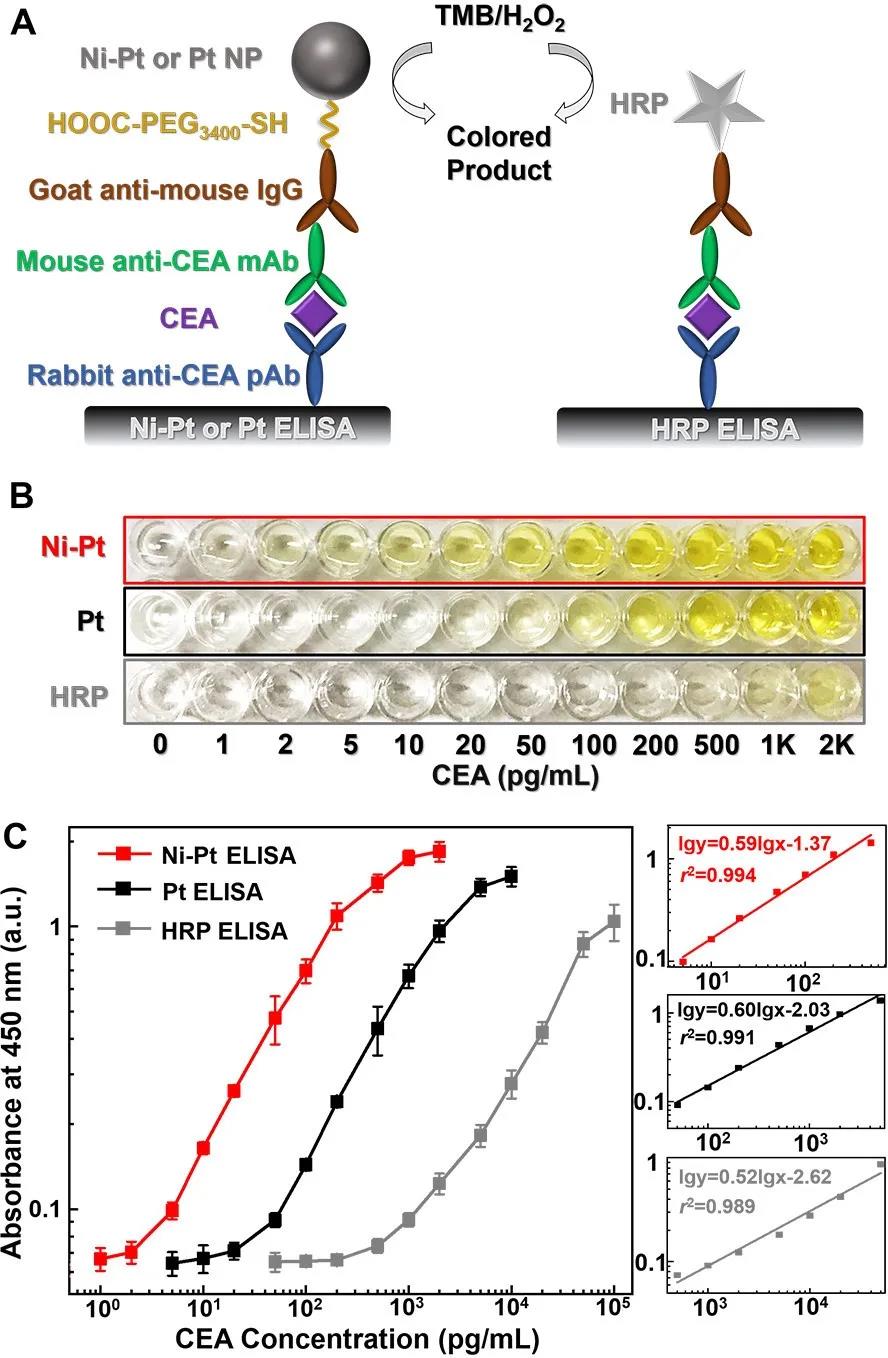Nickel-platinum nanoparticles: peroxidase mimics with high catalytic efficiency
QQ Academic Group: 1092348845
Detailed
In the past decade, nanoscale enzymes with peroxidase mimic activity have been widely developed. so far, a variety of inorganic nanomaterials have been found, such as carbon-based nanomaterials, metals and metal oxides, metal-organic skeleton (MOF) materials with peroxidase-like activity. However, as a key parameter to evaluate the catalytic performance of peroxidase mimics, the catalytic efficiency has not been significantly improved. In view of this, Professor Xiaohu Xia of the University of Central Florida and Professor Victor Fung of Oak Ridge National Laboratory reported a class of highly efficient peroxidase mimics, nickel-platinum nanoparticles (Ni-Pt NPs), composed of nickel-rich cores and platinum-rich shells.Ni-Pt NPs has high catalytic efficiency and ultra-low detection limit in CEA immunoassay.

Fig. 1. Ni-Pt NPs electron microscope characterization and comparison of enzyme-like catalytic efficiency of Ni-Pt nano-enzymes with different atomic ratios.
Catalytic efficiency largely determines the performance of peroxidase mimics in many applications because it measures the rate of signal generation, usually expressed as a catalytic constant (Kcat, is defined as the maximum number of substrate molecules converted into a product per unit time).
Kcat=vmax / [E].
Among them, vmax is the maximum reaction rate, and [E] is the concentration of nano-enzyme.
In this work, nanoparticles with different Ni/Pt atomic ratios (Ni-Pt2, Ni-Pt,Ni-Pt0.5 NPs) were obtained by simply changing the number of Ni and Pt precursors and keeping all other conditions unchanged. The characterization shows that the sizes of (i) Ni-Pt2 and Ni-Pt0.5 NPs nanoparticles are 12.7 ±2.1and 14.9 ±2.2nm, (ii), respectively. The three kinds of nm, (ii) nanoparticles have Ni-rich core and Pt-rich shell. Compared with Ni-Pt2 NPs, the Pt-rich shell of Ni-Pt0.5 NPs with the same structure is much thinner and the surface Ni content is higher.The peroxidase-like catalytic activities of three kinds of nano-enzyme materials were evaluated by H2O2 oxidation of 3pyrrolidine-5-tetramethylbenzidine (TMB) as a model reaction.

Figure 2. Peroxidase-like catalysis efficiency of NPs with different Ni/Pt ratio. Schematic diagram of catalytic oxidation of TMB by (A) H2O2. The initial reaction rate diagram of different NPs of (B) to TMB concentration. The error line represents the standard deviation of three independent measurements. Compare the histograms of Kcat and Kcat-specific of different NPs.
It can be seen from figure 2 that the Kcat values of nanoparticles with different Ni/Pt ratios show a volcanic dependence on Ni content, in which the KCA value of Ni-Pt NPs (Ni/Pt=1:1) is the highest, which is about 46 times and 104 times higher than that of Pt NPs and HRP, respectively. In addition, since all the active atoms on the surface of the noble metal peroxidase mimics contribute to their catalytic efficiency, the author uses the area specific efficiency (Kcat-specific, specific surface area normalized Kcat) to better describe the catalytic efficiency of these nano-enzymes, in which Ni-Pt NPs shows high catalytic efficiency.
In order to further clarify the catalytic efficiency of Ni-Pt NPs with excellent peroxidase-like activity, the H2O2 decomposition process on the surface of nanoparticles with different Ni/Pt ratios was calculated by density functional theory ((DFT)).Previous studies have assumed that the H2O2 decomposition mechanism on the surface of the metalloperoxidase mimic is carried out through H2O2 "2HO" H2O + O, while HO/O desorption and oxidation of TMB to oxTMB are the key reaction steps (steps IIIb and IV in Fig. 3A). Based on this, compared with the Ni,Pt surface, the HO/O adsorption on the Ni-Pt surface is the weakest, which is beneficial to the improvement of its peroxidase-like catalytic activity.

Figure 3. DFT calculation. Schematic diagram of H2O2 decomposition of (A) on Pt surface. The free energy diagram of H2O2 decomposition on the surface of (B) Ni-Pt,Pt and Ni and the optimized adsorption configuration of Ni-Pt surface. Planar models of various Ni-Pt surfaces of (C) (the red circle highlights a single Ni atom on top of the Pt). The adsorption energies of OH and O on the surface of Ni-Pt plane model in (D) (C). In each plate model, the blue atom represents Pt, and the orange atom represents Ni.
In addition, in order to understand the trend of volcanic catalytic efficiency with the increase of Ni content, the author modeled the surface based on the characteristics of the existence of Ni in the surface layer of Pt, and used the adsorption energy (Eads) of OH and O as descriptors. The results show that the formation of Ni core on a thinner Pt shell will have better peroxidase-like activity. However, if Ni atoms begin to diffuse to the top of the Pt surface (the Ni content increases), more surface Ni atoms will lead to a significant decrease in adsorption energy, thus reducing the catalytic activity.
Finally, in order to prove the potential application of Ni-Pt NPs in biomedical engineering, it was applied to the colorimetric enzyme-linked immunosorbent assay (Elisa) of carcinoembryonic antigen (CEA,), a typical cancer biomarker, and compared with Pt NPs and HRP ELISA.

Figure 4. Detection of CEA by ELISA based on Ni-Pt NPs,Pt NPs and HRP. Schematic diagram of three kinds of ELISA of (A) CEA. (B) is taken from a representative photo of the CEA standard ELISA. The corresponding calibration curve (left) and linear range area (right) of the test results in (C) (B). The error line represents the standard deviation of eight independent measurements.
The results show that the detection limits of, Pt NPs and HRP ELISA are about 13 times and 342 times higher than the detection limits of Ni-Pt NPs ELISA (1.1 pg/mL), respectively. The significant improvement of Ni-Pt NPs ELISA detection sensitivity is attributed to the ultra-high catalytic efficiency of Ni-Pt NPs relative to Pt NPs and HRP when other conditions remain unchanged.
In this work, it is proved that the Ni-Pt NPs (Kcat of a peroxidase mimic with record high catalytic efficiency is 4.5 × 107smur1). DFT calculations show that the excellent catalytic efficiency of Ni-Pt NPs is due to the fact that its unique surface structure weakens the adsorption of key intermediates in the catalytic process. Finally, Ni-Pt NPs is used for the sensitive detection of CEA, and the detection limit is hundreds of times lower than the traditional analysis method based on natural enzyme. Therefore, the peroxidase mimic (Ni-Pt NPs) proposed in this study may be widely used in biosensor, imaging and related fields.
This information is from the Internet for academic exchange only. if there is any infringement, please contact us to delete it immediately.
- Previous: Beihua Zhang Liqun/Pro
- Next: A Rising 2D Star: Nove


 Academic Frontier
Academic Frontier